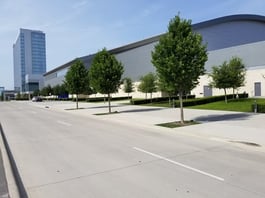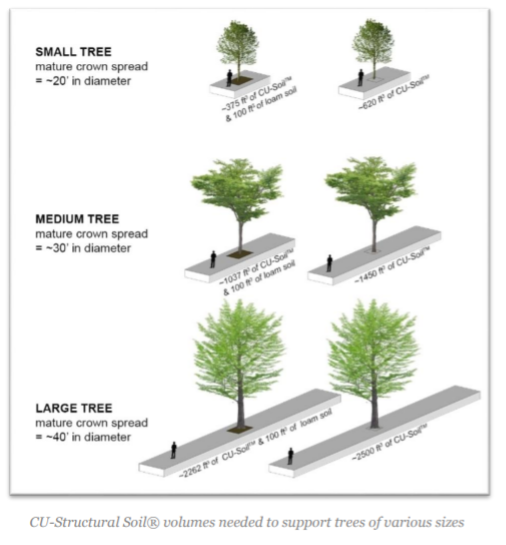What is Structural Soil?
Structural Soil is a soil developed by Cornell University and trademarked under the name 'CU-Soil®️'. CU Structural soil has been engineered to simultaneously meet the support needs of the pavements that stand on top of it and the requirements of the trees that are rooted in it. It is the answer to several expensive problems in the urban environment such as raised and cracked sidewalk cracks (which lead to tripping and potential lawsuits), early and frequent need for pavement repair, and poor drainage leading to puddles and muddy sidewalks. Additionally, it prolongs the life of street trees, so they don’t have to be replaced every 5-7 years.

Structural soil works as a 2-part system: a lattice of crushed stone, which provides the structural support and load-bearing capacity required by the work, and a carefully measured mix of heavy clay loam, which fills the gaps between the crushed rocks and promotes tree root growth, aeration and adequate water holding capacity.
The development of CU structural soil took place in Cornell University’s Urban Horticulture Institute, by a team including the renowned professor Nina Bassuk, and has been tested in the field for well over 15 years.
Helps with Soil Compaction
Soils under pavements tend to become compacted, because the weight of the traffic on them slowly crushes the pockets of air and water in the soil. This is a great problem for urban tree roots since they are forced to grow in soil that is as dense as a brick. Unable to grow downwards, roots grow horizontally or even upwards, causing the bulges and cracks in the sidewalks that we are all familiar with.
Read more about soil compaction, its causes and how to prevent and fix it here; we wrote a blog with lots of useful info.
Helps with Tree Growth in Urban Areas

Urban areas benefit from trees and green areas in their midst, which is why tree planting tends to be a high priority for city councils. However, under normal circumstances, those trees are doomed to die in 5 to 7 years, due to stunted root growth, soil compaction, and poor drainage, which will, in turn, cause health issues for the trees and accelerate their death. Using structural soil to support trees helps them develop healthy roots and grow to their full potential - the oldest field applications of structural soil are over 25 years old and performing as well as expected.
How Is Structural Soil Used?
CU- Structural Soil®️ was designed to provide sufficient soil volumes for tree roots under pavements and parking lots. According to the instructions, it is ideal under pedestrian mall paving, sidewalks, planting islands, and parking lots.
Urban Trees
CU-soil can be used before a pavement or parking lot has been built or added after the fact to prolong the life of trees and paved areas. Structural soil can be combined with sandy loam if there is a large enough opening around the tree, or it can be used on its own to extend the pavement closer to the tree trunk without compromising the tree’s health.

Pavements
Installing structural soil under a traditional porous pavement has many benefits when it comes to absorbing, distributing and storing stormwater. The main recommendation is to lay some geotextile between the structural soil and the mortared pavement (or the sand bed if no mortar is used), to discourage roots from growing in that direction.
Asphalt
Porous asphalt is a lot like regular asphalt, but it has its own specific mix to keep it porous and allow stormwater to seep through it instead of run over it. Structural soil is an excellent base under porous asphalt, and the amount of CU-soil required will depend on the type of soil underneath it. Additionally, storm drainage may be required - check your local regulations.

Saving Trees
Sometimes the trees are already there and you want to pave around them. Instead of leaving small “tree pits” of easily compacted soil,consider the structural soil trenches system, which uses the crown projected area of the tree to calculate how much structural soil will be required to keep it healthy. A small amount of structural soil can help you conserve a valuable and beautiful tree, and save a lot of money in repairs.
Turf
If structural soil is good for trees, imagine how good it will be for turf! While parking areas are not usually covered in turf, fire lanes are a frequent use of CU-soil and turf for an area which is not normally used for traffic, but which may on occasion have to withstand the weight of a fire engine. Structural soil has the necessary load-bearing capacity, and additionally, it will help with drainage so that stormwater is reabsorbed and deflected appropriately during the rainy season.
Where Can You Find CU Soil?
Structural Soil was patented and trademarked under the name 'CU- Structural Soil®️' to ensure consistency and quality control - there are other products around which claim to be structural soil, but they are not CU-soil. You can buy CU-structural soil from licensed producers and vendors, and Minick Materials is very proud to be one of them.









![All About Soil Compaction: Causes, Challenges & Solutions [A Guide]](https://www.minickmaterials.com/hs-fs/hubfs/Imported_Blog_Media/plants-2411458_1920-1024x683.jpg?width=725&name=plants-2411458_1920-1024x683.jpg)
.webp?width=725&name=AdobeStock_462076409%20(1).webp)